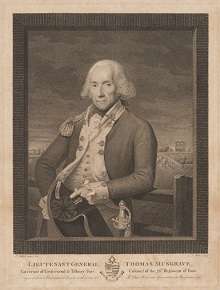Paoli Massacre: Part 2 of 7
Three Hours to Massacre

Sir Thomas Musgrave
1797 engraving by
Georg Siegmund Facius
based on 1786 work by
Lemuel Francis Abbott
At about 10 p.m. on the night of the 20th, General Grey set out with the 42nd and 44th Regiments, the 2nd Light Infantry, and a group of dragoons who moved west toward Wayne's camp. Grey was supported by Colonel Thomas Musgrave who would leave at 11 p.m. and march toward Paoli. He would block any attempted escape to the north. The combined British force was nearly 5,000 men — treble Wayne's troop strength. Their attack would be executed in the dead of night.
Sometime between 9 and 10 o'clock, Wayne was readying his attack plans, when an old man named Morgan Jones was brought before him. Jones warned Wayne that a local named Mr. Clayton employed a servant who had been captured and released by the British earlier in the evening. While in captivity, the startled servant had overheard British soldiers discussing an attack on Wayne which was to take place that very night.
Wayne dismissed the old man and his story. The Brigadier General had it on good authority that the British were headed for Philadelphia the next morning. Surely the servant must have been confused. Just in case, though, Wayne increased the number of pickets guarding the camp's perimeter and sent out more patrols to reconnoiter the road toward the enemy camp.
Whether Wayne believed that the British knew of his whereabouts or thought an attack forthcoming is difficult to say. Certainly the sounds of 1,500 men camping in the woods must have been heard; his forest campfires gave off smoke; further, the area was aswarm with Tories more than willing to sell out Wayne's location to the British. All in all, Wayne did not appear overly concerned.
Accordingly, as a light rain fell on the night of the 20th, Wayne continued preparing to attack the British again early the next morning. This time he hoped they would be on the move. Great care was taken to make sure the ammunition did not get wet. Guns, gunpowder, and cartridges were wrapped in cloth. He did not want to take any chances with scarce ammunition — 400,000 cartridges had been ruined at the Battle of the Clouds.



